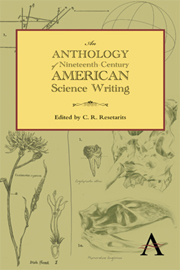Book contents
- Frontmatter
- Contents
- Preface
- Part One 1800–1846 Naturals and Naturalists
- Part Two 1846–1876 Warriors
- Part Three 1876–1900 Scientists
- Part Three Introduction
- “The Fixation of Belief” (excerpt), Popular Science Monthly (1877)
- “How to Make Our Ideas Clear” (excerpt) Popular Science Monthly (1878)
- “Catastrophism and Evolution” (excerpt), The American Naturalist (1877)
- “The Spectrum of an Argand Burner,” Science (1883)
- “The New Astronomy. I. Spots on the Sun” (excerpt), The Century (1885)
- “Screw,” Encyclopedia Britannica, vol. 21, 9th edition (1875–1889)
- “On the Relative Motion of the Earth and the Luminiferous Ether,” American Journal of Science (1887)
- “The Lake as a Microcosm” (excerpt), Bulletin of the Peoria Scientific Association (1887)
- “Laws of Temperature Control of the Geographic Distribution of Terrestrial Animals and Plants,” National Geographic Magazine (1894)
- “The Ecological Relations of the Vegetation on the Sand Dunes of Lake Michigan” (excerpt), Botanical Gazette (1899)
- “On the Equilibrium of Heterogeneous Substances, abstract,” American Journal of Science and Arts (1878)
- Bibliography
“Laws of Temperature Control of the Geographic Distribution of Terrestrial Animals and Plants,” National Geographic Magazine (1894)
from Part Three - 1876–1900 Scientists
Published online by Cambridge University Press: 05 June 2012
- Frontmatter
- Contents
- Preface
- Part One 1800–1846 Naturals and Naturalists
- Part Two 1846–1876 Warriors
- Part Three 1876–1900 Scientists
- Part Three Introduction
- “The Fixation of Belief” (excerpt), Popular Science Monthly (1877)
- “How to Make Our Ideas Clear” (excerpt) Popular Science Monthly (1878)
- “Catastrophism and Evolution” (excerpt), The American Naturalist (1877)
- “The Spectrum of an Argand Burner,” Science (1883)
- “The New Astronomy. I. Spots on the Sun” (excerpt), The Century (1885)
- “Screw,” Encyclopedia Britannica, vol. 21, 9th edition (1875–1889)
- “On the Relative Motion of the Earth and the Luminiferous Ether,” American Journal of Science (1887)
- “The Lake as a Microcosm” (excerpt), Bulletin of the Peoria Scientific Association (1887)
- “Laws of Temperature Control of the Geographic Distribution of Terrestrial Animals and Plants,” National Geographic Magazine (1894)
- “The Ecological Relations of the Vegetation on the Sand Dunes of Lake Michigan” (excerpt), Botanical Gazette (1899)
- “On the Equilibrium of Heterogeneous Substances, abstract,” American Journal of Science and Arts (1878)
- Bibliography
Summary
The tendency of animals and plants to multiply beyond the means of subsistence and to spread over all available areas is well understood. What naturalists wish to know is not how species are dispersed, but how they are checked in their efforts to overrun the earth. Geographic barriers are rare, except in the case of oceans, and since even these were formerly bridged at the north, another cause must be sought. This has been found in the group of phenomena commonly hidden under the word climate, and nearly a century ago it was shown by Humboldt that temperature is the most important of these climatic factors.
In the northern hemisphere animals and plants are distributed in circumpolar belts or zones, the boundaries of which follow lines of equal temperature rather than parallels of latitude. They conform in a general way, therefore, with the elevation of the land, sweeping northward over the lowlands and southward over the mountains. Between the pole and the equator there are three primary belts – Boreal, Austral and Tropical – each of which may be subdivided into minor belts and areas. In the United States the Boreal and Austral regions have each been split into three secondary transcontinental zones. The Boreal are known as the Arctic, Hudsonian and Canadian; the Austral as the Transition, Upper Austral and Lower Austral. The subordinate faunas and floras need not be here considered.
- Type
- Chapter
- Information
- An Anthology of Nineteenth-Century American Science Writing , pp. 267 - 276Publisher: Anthem PressPrint publication year: 2012
- 1
- Cited by



